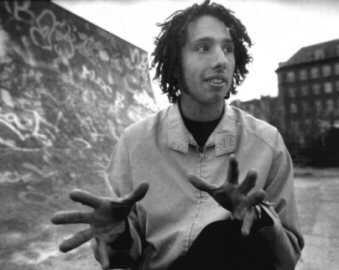|
Rage Against the Machine
|
Biographical
|
Zack de la Rocha: Vocals

"If today I had a young mind to direct, to start on the journey of
life, and I was faced with the duty of choosing between the natural
way of my forefathers and that of the... present way of civilization,
I would, for its welfare, unhesitatingly set that child's feet in the
path of my forefathers. I would raise him to be an Indian!"
Zacarias de la Rocha was born in Long Beach, CA, on January 12th,
1970 to his mother, Olivia, and his father, Beto. Olivia got her
Ph.D. in Anthropology on the Irvine campus of The University of
California. She lived in Irvine, a suburb of L.A. in Orange County,
with Zack after seperating from Beto when Zack was 1 year old.
Beto was a Chicano muralist, a member of the political art group the
"Los Four" which depicted pictures of the Mexican farmers, and paved
the way for Chicanos in the artistic community with their mix of
Hispanic iconography, graffiti and vibrant portraiture. Among their
first works were street paintings with three words: "Chicano Art
Existe!" - saying, bluntly, "here we are!"
In 1983, his father suffered a nervous breakdown due to excessive
religious ideals. He strictly applied the Bible's teachings to every
aspect of his life. Of the commandments, "Thou shalt not make
engraven image," Beto interpreted as reason to destroy his work and
quit painting. When Zack went to visit him on weekends in LA's Lincoln
Height, he would be forced to fast for days, to sit in a room with the
curtains closed and the door locked. He would eat on Friday, and not
eat until he returned to his mother on Monday. While there, he was
forced to help Beto destroy the paintings that established a sense of
Chicano identity for him. After a while, he couldn't cope with a such
a lifestyle any longer, and he permanantly lived with his mother in
Irvine - which was, at the time, perhaps one of the whitest cities in
Souther California, but is currently a racially and culturally
diverse area.
This brought on a culture shock and identity crisis. Being alienated
from the Chicano community, and falling into a world of white suburban
nature, where he - as a Chicano - was the exeption of the rule:
Chicanos were present only to if they had a hammer in their hand, were
selling strawberries, or sweeping streets. Zack found a channel for
his feelings through music. He got involved in the punk and hardcore
scene during his high school years, and played guitar and did vocals
for a straight-edge band called "Hardstance". He was interested in the
Sex Pistols, Bad Religion when he was younger, and evolved into
appreciating Minor Threat, Bad Brains, and Teen Idles."Inside Out" was
formed, and gained a large following in Huntington Beach and Irvine,
CA. They released a record, "No Spiritual Surrender," in 1991 on
Revelation Records and did a small tour. Inside Out, according to
Zack, "was about completely detaching ourselves from society to see
ourselves as...as spirits, and not bowing down to a system that sees
you as just another pebble on a beach. I channeled all my anger out
through that band." Zack's Chicano heritage always seperated him from
the rich, white kids that surrounded him, however. Although he was
never economically deprived like his Chicano brothers and sisters, he
felt the tension and rejection. He began to relate to hip-hop acts
such as Public Enemy, KRS-One, and Run DMC. After Inside Out broke up,
he embraced his hip-hop foundation further, and began freestyle
rapping at local clubs. He met Tom Morello and Brad Wilk, and after
adding Tim Commerford to the mix, Rage Against the Machine was formed.
"You can't ignore what some bands have done. I know that from my
own experience, from the way my life was changed by "Fuck Armageddon,
This is Hell" by Bad Religion. I know our record will be in a bin
next to Lionel Richie -- but so are John Coltrane, KRS-1, and Public
Enemy."
Since singing for Rage Against the Machine, Zack has used the band's
worldwide fame to educate the public about the political issues that
concern him - through his music and lyrics, to his actions on a
grassroots level. He has organized several student trips to Chiapas,
Mexico, to aid the Zapatista communities being terrorized by the
government. He has spoken to the United Nations Commission on Human
Rights in Geneva about political prisoner Mumia Abu-Jamal. While at
home, he has organized a community center. His work in RATM has
encouraged his father to begin painting again. I think he kind of saw
in me a reflection of himself that he used to know. All the stuff he
was once very in touch with - I saw the imagery coming back in his
work." One recent series by Beto incorporates small dolls of Zapatista
figures - like those actually made and sold by the Indians in
Chiapas - against images of historic Mexican revolutinoaries such as
Emiliano Zapata and Pancho Villa. He continues to teach kids around
the world, and learn from people he meets. His political, social,
and musical contributes are quickly elevating him as a Bob Marley
figure.
<<<<< back to central
